7 Tried-and-True Solutions for Food-Container Clutter That I Swear by

My stockpile of food containers tends to multiply without any perceivable action on my part. Before I realize it, I have more takeout containers and glass jars than can fit in the drawer where I store them; they clutter my space and stress me out.
I recently overhauled my food container storage, but as we all know, that’s only step one. The all-important next step is following the one in, one out rule, but that requires deciding what “out” actually means. If I don’t have a solid plan for dealing with the excess containers that magically appear in my kitchen, all that organizing work will be for naught.
Luckily, I’ve got plenty of options for getting rid of food containers I no longer need.
Give them away.
This is my first stop because it’s so easy. Once I’ve gathered a quorum of extra containers, I take a photo and post it to my local Buy Nothing group. If you don’t have an active Buy Nothing group in your area, try Freecycle, Craigslist’s free section, Facebook Marketplace’s free listings, or Nextdoor. There are always people willing to pick up containers from my front door — usually home cooks who share food with friends and neighbors.
Share food.
Speaking of sharing food, this is another great option for getting rid of those containers. Not only does this practice reduce food waste, but it also creates connections with people you might otherwise ignore. A takeout container full of banana pudding cookies can be the key to having an ally across the hall.
Use them to store non-food items.
Food containers can hold a lot more than food. I use baby food jars to store screws in the basement, stackable deli containers to sort craft supplies in the closet, and (when my kids were younger) bento-style takeout containers to hold LEGOs and other small toys on road trips.
Organize drawers.
Shallow, rectangular food containers are a great way to organize drawers — no trip to The Container Store required.
Store holiday decorations.
Food containers are the perfect size for protecting the fragile handmade ornaments my children made when they were in preschool. These uniquely sized creations don’t always fit in standard ornament boxes, and separate containers keep them safe.
Use plastic containers as seed starters.
I can keep a houseplant or two alive, but I do not pretend to have a green thumb. I do, however, have neighbors who use takeout containers for indoor starts leading up to spring planting season.
Recycle them.
This is my last resort, because it usually takes a little research, especially if the containers are plastic. In my neighborhood, Ridwell will take flat plastic lids and No. 1 PET plastic. My curbside recycling will take most round plastic containers, and my city’s Find a Recycler program helps me find a home for the rest.
Having a system in place to eliminate container clutter is a game-changer. I was drowning in food containers until I found the exit strategy that works for me. Now I can simply enjoy my leftovers.
What do you do with excess food containers?

